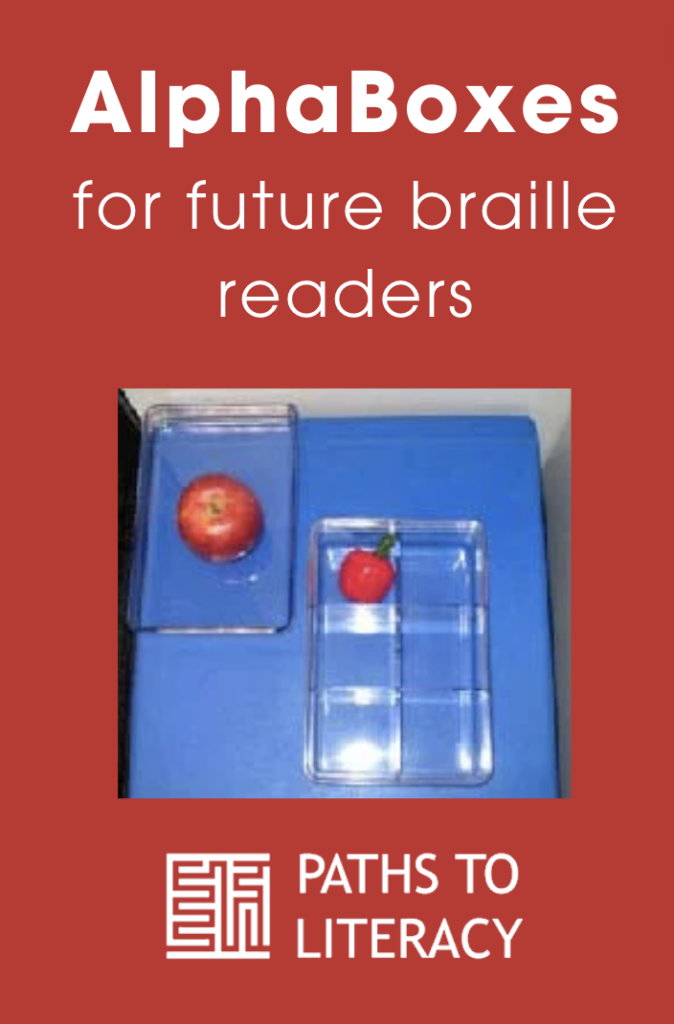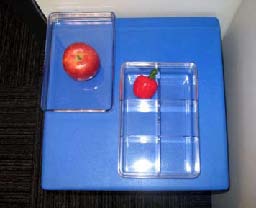By Anne McComiskey, BEGIN Program Director, Center for the Visually Impaired, Atlanta, Georgia
The AlphaBox game is designed to teach braille letters to emergent readers. The activity uses a container with six compartments representing a braille cell and functional objects that are familiar to young children with limited or no vision. The game helps children learn the dot configuration of braille letters by arranging objects to match the pattern of each letter. The objects used for teaching each letter begin with that letter (not necessarily phonetically). The number of items used corresponds to the number of braille dots that form the letter. For example, one plastic apple could represent the letter “a” when placed in the upper left section of the AlphaBox. The game is easily expanded to meet individual learning needs.
It is extremely important that the AlphaBox game be fun. Love of reading can be killed by rigorous drill without fun and rewards. The game is intended to be enjoyable for the student and the only absolute rule is that it be shared in fun ways.

Supplies
- A 6-section muffin tin or and 8-inch-square box that is divided into six sections that are arranged in three vertical rows of two compartments each to represent a braille cell.
- 26 large zip-lock bags or envelopes labeled in large print and braille, one for each letter of the alphabet; for functional braille readers, add a tactile cue to each envelope the child is working on.
- A method of organizing the 26 containers, such as a large metal clip ring for the bags or a large file box to hold the envelopes
- One work tray
Alphabet items:
A. 1 apple
B. 2 balls
C. 2 cups
D. 3 dishes
E. 2 eggs
F. 3 flowers
G. 4 gum sticks
H. 3 horns
I. 2 insects
J. 3 jelly beans
K. 2 Keys
L. 3 locks
M. 3 marbles
N. 4 nuts
O. 3 Oreos (mini0

P. 4 peanuts
Q. 5 quarters
R. 4 rings
S. 3 soaps
T. 4 trucks
U. 3 umbrellas-drink size
V. 4 Velcro pieces
W. 4 whistles
X. 4 xylophones sticks
Y. 5 yo-yos
Z. 5 zippers
You can certainly use different items. I suggest these because they are familiar and are easy to find in stores. Larger items might be represented by a piece, such as suggested for the xylophone. It is helpful if the item already has meaning for the child, and is something the child can play with or eat.
Teaching Suggestions
- Establish the concept that the braille cell has six little “rooms” or spaces. Demonstrate this with a page that illustrates a large braille cell. Relate the cell to the box with the 6 sections. Name and label each section with its appropriate dot numbers.
1 4
2 5
3 6
- Build units of learning and experience around the introduction of each letter.
- Have the child find the proper bag. An adult may need to help the child examine the braille letter on the bag and, if appropriate, read the large print label. Talk about the letter, say the letter’s sound, and identify other objects that begin with the letter.
- Open the bag and remove the items. Place them on the tray. If the items are representative of a real object, have the real object available to compare and discuss with the student (e.g. how is this small plastic apple like this real apple?).
- Help the child put the items in the sections that correspond to the dot configuration of the letter.
- Remove the items and repeat putting them in the sections, saying the dot number in sequence as you do. Make this step interesting and creative.
- Work with the child to identify other items that could represent that letter. Help collect these additional items and make another bag or envelope for each new set.
- After the child is totally familiar with the placement of a letter’s dot configuration and its sound, replace the items in the AlphaBox with balls, chips, or even round cereal. Have the child identify the letter by the dot numbers that are formed.
- Gradually expand the game by having the child start making a booklet with pages that have several repetitions of the braille letters being learned through the AlphaBoxes.
- The child can make this book using a brailler or slate and stylus.
- AlphaBox items can also be glued on braille paper to represent their placement in a braille cell.
- Work in short sessions and have fun!
- Be a little silly.
- Be active whenever possible.
- Make up songs and rhymes about the letter.
- Tell a silly story about the letter.
- Let the child tell you a poem or story about the item and the letter.
- Braille the story and put it into a book for the child. Print the words above the braille so parents can enjoy the child’s story too.
- Remember: there is no failure in this game.
This article was originally published by Texas School for the Blind and Visually Impaired (TSBVI) and is reprinted here with permission.





